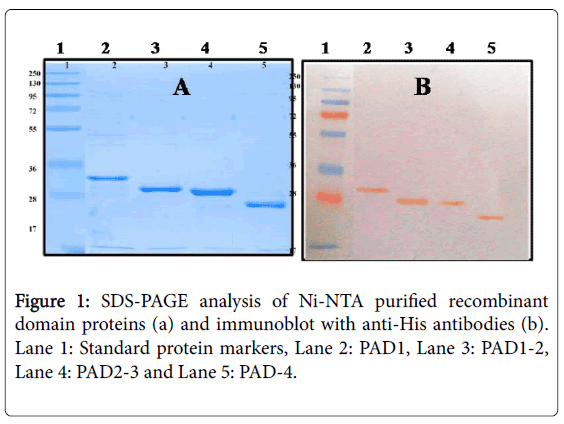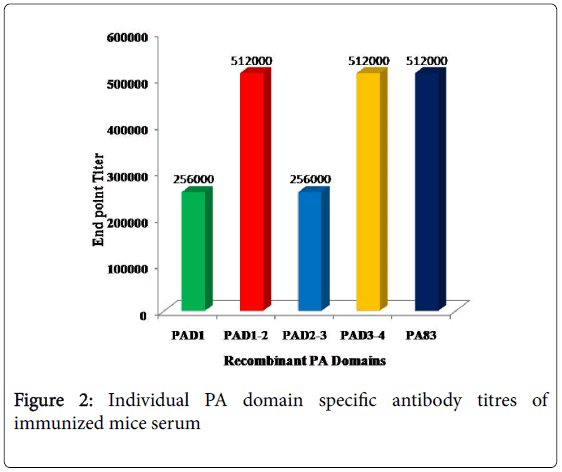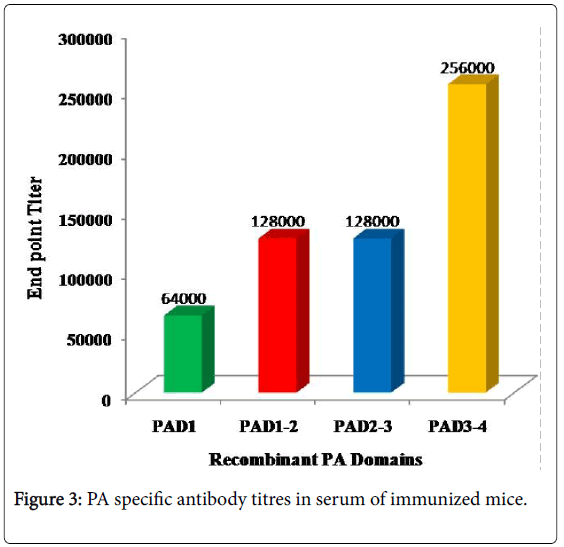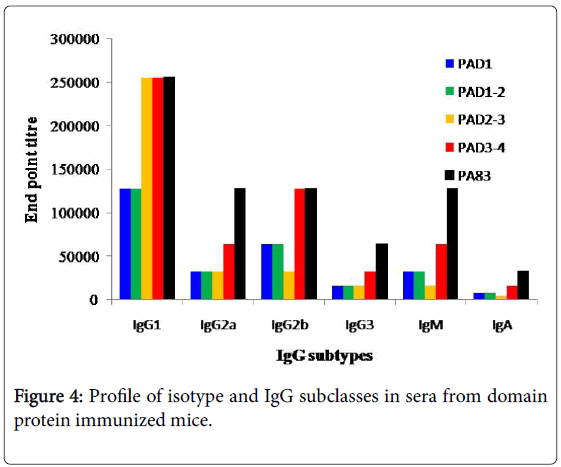Research Article Open Access
Development of Recombinant Domains of Protective Antigen of Bacillus anthracis and Evaluation of their Immune Response in Mouse Model for Use as Vaccine Candidates for Anthrax
Anshul Varshney and Goel AK *
Biotechnology Division, Defence Research and Development Establishment, Jhansi Road, Gwalior, India
- Corresponding Author:
- Goel AK
Biotechnology Division
Defence Research and Development Establishment
Jhansi Road, Gwalior, India
Tel: 91-751-2233742
E-mail: akgoel73@yahoo.co.uk
Received date: May 25, 2016; Accepted date: June 06, 2016; Published date: June 12, 2016
Citation: Varshney A, Goel AK (2016) Development of Recombinant Domains of Protective Antigen of Bacillus anthracis and Evaluation of their Immune Response in Mouse Model for Use as Vaccine Candidates for Anthrax. J Bioterror Biodef 7:147. doi: 10.4172/2157-2526.1000147
Copyright: © 2016 Vashney A, et al. This is an open-access article distributed under the terms of the Creative Commons Attribution License, which permits unrestricted use, distribution, and reproduction in any medium, provided the original author and source are credited.
Visit for more related articles at Journal of Bioterrorism & Biodefense
Abstract
Bacillus anthracis, the causative agent of anthrax is considered as the most important biological warfare agent. This Gram-positive, spore forming bacterium has three modes of infection i.e. cutaneous, inhalational and gastrointestinal in human. The principal virulence factors of this bacterium consist of an anti-phagocytic capsule composed of poly-D-glutamic acid and a secreted tripartite bacterial toxin composed of protective antigen (PA), lethal factor (LF) and edema factor (EF). PA is the pivotal protein of the anthrax toxin complex and immune response to PA is central to protection against B. anthracis. In this study, overlapping portions of four different domains of PA were cloned and expressed. The recombinant proteins were purified and used for immunization in mice. The ELISA results showed that all the domains elicited high antibody titres in vaccinated animals. However domain PAD3-4 showed the highest immune response against PA. Among the IgG subtypes, IgG1 response was predominant in all the immunized groups followed by IgG2. This indicated the induction of Th2 type immune responses against all the recombinant protein vaccine candidates. The study showed that the individual domains have also the potential as vaccine candidates for anthrax.
Keywords
Anthrax; Bacillus anthracis ; Immune response; Protective antigen; Vaccine
Introduction
Anthrax, primarily a disease of herbivores and domestic livestock, is caused by the Gram positive, spore-forming bacterium, Bacillus anthracis . In human, there are three modes of its infection, cutaneous, gastrointestinal and inhalational. The virulence of bacterium is due to the capsule and a tripartite toxin produced by the B. anthracis [1]. Two plasmids, pXO1 and pXO2 carry the genes encoding toxin and capsule, respectively. Anthrax toxin, a tripartite toxin comprised of protective antigen (PA), lethal factor (LF) or edema factor (EF). PA is the common protein which facilitates the entry of LF or EF into the host cell [2,3]. PA is an 83 kD protein that initially binds to ubiquitously expressed cell surface receptors [4-6]. This binding is followed by cleavage of PA by cell-associated furin-like proteases, releasing a 20- kDa fragment to produce the activated form, PA63 [7,8]. The next steps are formation of a heptamer of PA63 molecules and binding of LF (or EF) to PA63 [9,10]. The PA63-LF (or PA63-EF) complexes are internalized, likely via a lipid raft-mediated process, and within the acidic environment of the endosomes, LF and EF are translocated into the target cell cytoplasm [11,12] where they exert their toxic effects [13-15].
PA contains four domains and each domain has a specific role in intoxication process. Individual domain can exist separately from the full protein while retaining its structural and functional integrity [16]. Domain 1, comprising of amino acids (aa) 1-258 contains the furin recognition site RKKR, which is cleaved to release the N-terminal PA20 (1-167) fragment. The remaining protein (PA63) is heptamerized through monomeric interactions of the cell surface [17]. Domain 1 has Ca2+ binding sites also which provide stability to PA [18]. Domain 2 (residue aa 259 to 487) and Domain 3 (aa 488 to 595) contribute toward heptamerization, and internalization of LF or EF through receptor-mediated endocytosis into the cell [9,19]. Domain 2 forms the heptameric pore through which the effector molecules traverse to enter the cytosol. Domain 4 (residues 596 to 735) possesses the receptor for binding to the host cell [19,20].
PA, being the central moiety of the anthrax toxin has been a major target for development of anthrax vaccine. However, the currently FDA approved anthrax vaccine anthrax vaccine adsorbed’ (AVA), or BioThrax is prepared by adsorbing filtered culture supernatants of an attenuated strain (V770-NP1-R) to Aluminum hydroxide (Al hydrogel) as an adjuvant [21]. AVA was developed in the early 1950s when purified components of B. anthracis were not available. However, still its major demonstrable protective component is PA protein [22]. Now, there is a complete understanding of the molecular mechanism of anthrax pathogenesis and the individual protective components can be produced easily. Thus, new generation anthrax vaccines are being developed where major component is purified preparations of recombinant PA.
The role of full PA has been well demonstrated in protection. However, in this study, we have demonstrated the potential of recombinant PA domains. The overlapping gene part of individual domains of PA were cloned and expressed in E. coli. The proteins were purified to homogeneity and used for immunization in mice. The immune response in terms of specific IgGs and their isotopes for individual domains and against whole PA was determined.
Materials and Methods
Cloning, expression and purification of PA domain proteins
The DNA encoding different domains were amplified by PCR using the B. anthracis Sterne DNA. The primers used for amplification of these truncated portions of PA are listed in (Table 1). The PA Domain 1 (PAD1), PA Domain 1-2 (PAD1-2), PA domain 2-3 (PAD2-3) and PA domain 3-4 (PAD3-4) consisted of 702, 681, 621 and 543 nucleotides, respectively. Thus, the amplified fragments consisted of the overlapping regions of domains instead of complete individual domain. The amplified DNA fragments were cloned into the expression vector pQE30-UA (Qiagen) in accordance with the manufacturer's instructions. Ligated vectors were then transformed into E. coli SG13009 cells and the transformants were selected on the media plates containing ampicillin (100 μg/ml) and kanamycin (25 μg/ ml). The presence of inserts was confirmed by the sequencing (data not shown). Recombinant proteins were expressed at 37°C after IPTG induction and purified in denaturing conditions by Ni-NTA columns (Qiagen) as described by the manufacturer. The purified recombinant proteins were dialyzed and estimated by bicinchoninic acid (BCA) method using BCA from Sigma, USA.
| Domain primer | Oligo sequence | Amplicon size (bp) |
|---|---|---|
| PAD1 | GAGGTGATTCAGGCAGAAG | 702 |
| AGCCGTGCTCCATTTTTCAG | ||
| PAD1-2 | GTATCACCAGAGGCAAGACAC | 681 |
| TGTATCCACCCTCACTCTTC | ||
| PAD2-3 | ATTGGTGGGAGTGTATCTGC | 621 |
| TGTCATATCCGGTTTAGTCG | ||
| PAD3-4 | CAAGGGAAAGACATAACCGA | 543 |
| TTTCTTGATCCCGTTGGTAC |
Table 1: List of oligos used in the study
Purified proteins (2μg/well) were separated by 12% SDS-PAGE. Samples were electrophoresed in two gels. One was stained with Coomassie brilliant blue G-250 and the other was electro blotted on to a transfer membrane (PVDF). Since pQE-30UA vector provides Nterminal His-tag to the recombinant proteins, presence of proteins was confirmed by western blotting with anti- his antibody.
Animal immunization
All animal procedures were adhered strictly to the Institutional Animal Ethics Committee (IAEC). Groups of six mice (female BALB/c) each weighing 20-25 g received three doses of PA domain antigens at intervals of 2 weeks, subcutaneously (s.c.). PA or its domain antigens (20 μg) were administered with Freunds adjuvant in 10 mM phosphate buffer pH 7.4. Control group was immunized with PBS only. Mice were immunized on day 0 and boosted two more times on a 2-week schedule. One week after final immunization, mice were bled and serum was separated and stored at −20°C until used.
Measurement of antigen specific immunoglobulins
The serum IgG antibody titres to PA and its domains were determined by enzyme linked immunosorbent assay (ELISA). Maxisorp flat bottom 96-well microtiter plates (Nalge Nunc International, Denmark) were coated with 100 μL per well of different PA proteins (2 μg/ml) per well in carbonate buffer, pH 9.6 overnight at 4°C. The antigen coated plates were washed three times with wash buffer (PBS containing 0.1% Tween 20) using ELx 50 microplate washer (BioTek Instruments Inc, USA). The wells were blocked with 300 μL of blocking buffer (5% skimmed milk in PBS) for 1 h at 37°C. After washing, the plate was blotted dry on a paper towel. The test and control sera were diluted to 1:2000 to 1:512000 in PBS containing 1% skimmed milk, pH 7.4. The final volume in each well was 100 μL and incubated for 60 min at 37°C. The plate was then washed three times with wash buffer and blotted dry on a paper towel. Horseradish peroxidase (HRP)-conjugated goat anti-mice IgG (Sigma Aldrich, USA) diluted to 1:10000 in PBS containing 1% skimmed milk (100 μL / well) was added and incubated for 60 min to detect the bound anti-PAIgG. Again the plate was washed three times with wash buffer and detected calorimetrically by using 100μL per well of TMB (3, 3’, 5, 5’- tetramethylbenzidine) (Sigma Aldrich, USA) and incubated at room temperature for 10 min. The colour development was stopped with 100μL of 1N H2 SO4 and read at 450 nm using an ELISA plate reader (BioTek Instruments Inc, USA). All the tests were performed in duplicate. Antibody titres were expressed as reciprocal of the end point dilution.
Measurement of PA specific immunoglobulins
Sera were examined for the level of PA specific IgGs by ELISA. PA, obtained from α Diagnostic, USA (1 μg/ml, 100 μL) was coated into 96-well plates (Nunc, Denmark) in duplicates. The ELISA was performed as described above using the test and control sera from various mice groups.
Detection of isotope specific antibodies to PA
ELISA was used to determine the isotopes and subclass specificities of antibodies to PA. Plates were coated with the rPA domain proteins and serial two-fold dilutions of sera from immunized and control mice were added. Isotope specific antibodies (goat anti-mouse IgG1, IgG2a, IgG2b and IgG3, IgM and IgA from BioRad, USA at 1:1000 dilutions) were added in duplicates and detection of bound isotope specific antibodies was performed with HRP conjugated rabbit anti-goat IgG (1:5000) and TMB substrate. The absorbance was read at 450 nm. Antibody titres were expressed as reciprocal of the end point dilution.
Results
Cloning and expression of recombinant PA domain antigens
The amplicon size of PAD1, PAD1-2, PAD2-3 and PAD3-4 were 702, 681, 621 and 543 bp, respectively. Ligation of the amplicons with pQE-30UA vector resulted in addition of 78 bp to the target gene, thus resulting final DNA fragments of 780, 759, 699 and 621 bp. All recombinant domain proteins were expressed in E. coli SG13009 cells and grown in Luria broth (LB) at 37°C and induced with IPTG, The growth conditions for each recombinant domain were optimized for maximal expression and yield. The growth conditions for domain PAD1, PAD1-2 and PAD2-3 were 1.0 mM IPTG, and 4 h induction at 37°C. However and PAD3-4 performed best at induction period of 3 h; with the addition of 1.0 mM IPTG at 37°C.
Purification of recombinant PA domain proteins
All the recombinant proteins having Histidine fusion tag were purified by Ni-NTA chromatography under denatured condition. All the proteins were found to be present in insoluble fraction of cell lysate as revealed by SDS-PAGE. Proteins were eluted using denaturing elution buffer, as per the manufacturer’s instructions. All the recombinant proteins were checked by SDS-PAGE (Figure 1A). The proteins were quantified using BCA method. Proteins were then stored at 70°C until used. Various clones yielded 6.0 mg (PAD1), 12.9 mg (PAD1-2), 22.3 mg (PAD2-3) and 19.2 mg (PAD3-4) proteins from one litre of shake flask culture. The western blot of the purified recombinant proteins is shown in Figure 1B.
Antibody titers of individual domain proteins by plate ELISA
An indirect IgG ELISA was performed to determine the antibody response elicited by individual recombinant domain antigen in mice. Figure 2 shows antibody titers of pooled sera from 6 animals with individual domain antigens. Domain PAD3-4, PAD1-2 elicited an excellent antibody titre (1: 512000). This titre was equivalent to antibody tire produced by full PA (Figure 2). Other two domains i.e. PAD1 and PAD2-3 also showed good antibody response in the immunized mice. Our results indicated that domain PAD3-4 and PAD1-2 proteins are the immuno-dominant antigens in magnitude of response, with a titre of 1:512000 (Figure 2). Other PA domains also showed good antibody titres of 1: 256000.
Antibody response of individual domain proteins against full PA
In order to determine the immune response of vaccinated sera against full PA83 protein, a separate ELISA was performed by coating Full PA as antigen. The highest antibody response against PA83 (full PA) was exhibited by domain PAD3-4 (1:256000) followed by domain PAD2-3 and PAD 1-2 (Figure 3).
Antibody isotyping
The mice sera were evaluated for specific IgM, IgG subclass, and IgA antibodies to PA. Among the IgG subtypes, IgG1 response was predominant in all the immunized groups followed by IgG2b and IgG2a with respect to pre-immunized sera (Figure 4). The IgG1 response of PAD2-3, PAD3-4 and full PA was identical. In domain PAD2-3, no significant difference was observed between IgG2b and IgG2a (Figure 4).
Discussion
Anthrax is an important disease of biodefense concern [23]. Besides, it is a public health problem also in countries with agriculture as the major occupation. India has got the largest livestock population of the world. Many regions in India are still enzootic for anthrax [24]. In some states like Orissa and Andhra Pradesh, anthrax is endemic and a public health problem in many areas [25,26]. The immune system response generated during infection is generally effective in eliminating the foreign agent and comprise many different efficient antimicrobial activities. However, for disease like anthrax, development of an effective vaccine for anthrax is a need of the day.
Antibodies generated during bacterial infection may play an important role by binding to the bacterial surface and have potent effector functions that can lead to bacterial lysis via complement, or facilitate phagocytosis by immune cells via Fc receptors (FcRs). Antibody mediated removal of bacterial pathogens can require either any one, or combinations, of these activities. For example, bacteria in the lungs can be unaffected by antibodies in the absence of complement components or FcRs, indicating that a complex combination of Fc-associated effector functions is required for bacterial clearance [27]. Respiratory Bacterial pathogens have been shown to induce immunity that is dependent on T cells or on specific antibody effector functions and can even be dependent on the combination of both antibody effector functions and T cells [28].
Considering that B. anthracis has mechanisms to affect T-cell functions that could disrupt the generation of various immune functions, it is important to understand the mechanism of anamnestic immunity to this pathogen. Antibodies are necessary for protective immunity to B. anthracis . In this study, various domains of PA were generated to study their antibody response in mouse model. Each domain plays a critical role in toxin action, whether it be effector binding (domain 1) [9], participation in oligomer formation (domain 3) [9,19], or receptor binding (domain 4) [19,20], for that reason assessment of the domain-specific antibody levels generated by immunization with PA domains antigen in mice was studied. The results showed that among all the domains PAD3-4 and PAD1-2 showed highest antibody response (1:256000) followed by PAD2-3 and PAD1. Interestingly, maximum immune response against full PA was also shown by domain PAD3-4, followed by PAD1-2, PAD2-3 and PAD1. A significant high antibody titer with predominance of IgG1 isotopes along with elevated level of IgG2b was observed for PAD3-4, followed by PAD1-2, PAD2-3 and PAD1 antigen (Figure 4). There are different subclasses of IgG immunoglobulins such as IgG1, IgG2a, IgG2b, and IgG3 that provide immunity to most infectious agents. This isotope switch is controlled by T-cells and their cytokines. In mice, IL-4 generally switches activated B cells to the IgG1 isotope (Th2 type immune response) [29]. It appears from these findings that domain antigens immunization in mice induces Th2 type of immune response that may provide protective immunity in mice. The study shows that these recombinant domains proteins can be used as an improved vaccine candidate against anthrax in future.
Acknowledgements
The authors are thankful to Director, Defence Research and Development Establishment, Gwalior for providing the necessary facilities.
Conflict of Interests
There is no conflict of interest regarding the publication of this article
References
- Collier RJ, Young JAT (2003) Anthrax toxin. Annu Rev Cell DevBiol 19:45-70
- Mock M, Mignot T (2003) Anthrax toxins and the host: a story of intimacy. Cell Microbiol 5:15-23
- Turk BE (2007) Manipulation of host signalling pathways by anthrax toxins. Biochem J 402:405-417.
- Bradley KA, Mogridge J, Mourez M, Collier RJ, Young JA (2001) Identification of the cellular receptor for anthrax toxin. Nature 414:225-229.
- Scobie HM, Rainey GJ, Bradley KA, Young JA (2003) Human capillary morphogenesis protein 2 functions as an anthrax toxin receptor. ProcNatlAcadSci USA 100:5170-5174.
- Friedlander AM, Bhatnagar R, Leppla SH, Johnson L, Singh Y (1993) Characterization of macrophage sensitivity and resistance to anthrax lethal toxin. Infect Immun 61:245-252.
- Klimpel KR, Molloy SS, Thomas G, Leppla SH (1992) Anthrax toxin protective antigen is activated by a cell surface protease with the sequence specificity and catalytic properties of furin. ProcNatlAcadSci USA 89:10277-10281.
- Leppla SH, Friedlander AM, Cora EM (1988) Proteolytic activation of anthrax toxin bound to cellular receptors. Guistav Fisher New York.
- Petosa C, Collier RJ, Klimpel KR, Leppla SH, Liddington RC (1997) Crystal structure of the anthrax toxin protective antigen. Nature 385:833-838.
- Singh Y, Klimpel KR, Goel S, Swain PK, Leppla SH (1999) Oligomerization of anthrax toxin protective antigen and binding of lethal factor during endocytic uptake into mammalian cells. Infect Immun 67:1853-1859
- Friedlander AM (1986) Macrophages are sensitive to anthrax lethal toxin through an acid dependent process. J BiolChem 261:7123-7126.
- Milne JC, Furlong D, Hanna PC, Wall JS, Collier RJ (1994) Anthrax protective antigen forms oligomers during intoxication of mammalian cells. J BiolChem 269:20607-20612.
- Duesbery NS, Webb CP, Leppla SH, Gordon VM, Klimpel KR, et al. (1998) Proteolytic inactivation of MAP kinase kinase by anthrax lethal factor. Science 280:734-737.
- Leppla SH (1982) Anthrax toxin edema factor: a bacterial adenylatecyclase that increases cyclic AMP concentrations of eukaryotic cells. ProcNatlAcadSci USA 79:3162-3166.
- Vitale G, Pellizzari R, Recchi C, Napolitani G, Mock M, et al. (1999) Anthrax lethal factor cleaves the N terminus of MAPKKS and induces tyrosine threonine phosphorylation of MAPKS in cultured macrophages. J ApplMicrobiol 87:288.
- Jaenicke R (1999) Stability and folding of domain proteins. ProgBiophysMolBiol 71:155-241.
- McBride BW, Mogg A, Telfer JL, Lever MS, Miller J, et al. (1998) Protective efficacy of a recombinant protective antigen against Bacillus anthracis challenge and assessment of immunological markers. Vaccine 16:810-817.
- Gupta PK, Chandra H, Gaur R, Kurupati RK, Chowdhury S, et al. (2003) Conformational fluctuations in anthrax protective antigen: a possible role of calcium in the folding pathway of the protein. FEBS Lett 554:505-510.
- Little SF, Novak JM, Lowe JR, Leppla SH, Singh Y, et al. (1996) Characterization of lethal factor binding and cell receptor binding domains of protective antigen of Bacillus anthracis using monoclonal antibodies. Microbiology 142:707-715
- Lacy DB, Wigelsworth DJ, Melnyk RA, Harrison SC, Collier RJ (2004) Structure of heptameric protective antigen bound to an anthrax toxin receptor: a role for receptor in pH dependent pore formation. Proc Nat AcadSci 101:13147-13151.
- Brey RN (2005) Molecular basis for improved anthrax vaccines. Adv Drug Deliv Rev 57:1266-1292.
- Turnbull PC, Broster MG, Carman JA, Manchee RJ, Melling J (1986) Development of antibodies to protective antigen and lethal factor components of anthrax toxin in humans and guinea pigs and their relevance to protective immunity. Infect Immun 52:356-363.
- Goel AK (2015) Anthrax: A disease of biowarfare and public health importance. World J Clin Cases 3:20-33.
- Rao TN, Venkatachalam K, Ahmed K, Padmaja IJ, Bharthi M, Rao PA (2009) A mini outbreak of cutaneous anthrax in Vizianagaram District Andhra Pradesh India. Indian J Dermatol Venereol Leprol 75:416-418
- Aujesky D, Roy PM, Verschuren F, Righini M, Osterwalder J, et al. (2011) Outpatient versus inpatient treatment for patients with acute pulmonary embolism: an international open label randomised non inferiority trial. Lancet 378:41-48.
- Kumar A, Kanungo R, BadrinathS (2000) Anthrax in Pondicherry South India. J Med Microbiol 49:1129.
- Kirimanjeswara GS, Mann PB, Pilione M, Kennett MJ, Harvill ET (2005) The complex mechanism of antibody mediated clearance of Bordetella from the lungs requires TLR4. J Immunol 175:7504-7511.
- Mills KH, Ryan M, Ryan E, Mahon BP (1998) A murine model in which protection correlates with pertussis vaccine efficacy in children reveals complementary roles for humoral and cell-mediated immunity in protection against Bordetella pertussis. Infect Immun:594-602.
- Dziarski R (2006) Deadly plague versus mild mannered TLR4. Nat Immunol 7:1017-1019.
Relevant Topics
- Anthrax Bioterrorism
- Bio surveilliance
- Biodefense
- Biohazards
- Biological Preparedness
- Biological Warfare
- Biological weapons
- Biorisk
- Bioterrorism
- Bioterrorism Agents
- Biothreat Agents
- Disease surveillance
- Emerging infectious disease
- Epidemiology of Breast Cancer
- Information Security
- Mass Prophylaxis
- Nuclear Terrorism
- Probabilistic risk assessment
- United States biological defense program
- Vaccines
Recommended Journals
Article Tools
Article Usage
- Total views: 12784
- [From(publication date):
June-2016 - Apr 03, 2025] - Breakdown by view type
- HTML page views : 11715
- PDF downloads : 1069




